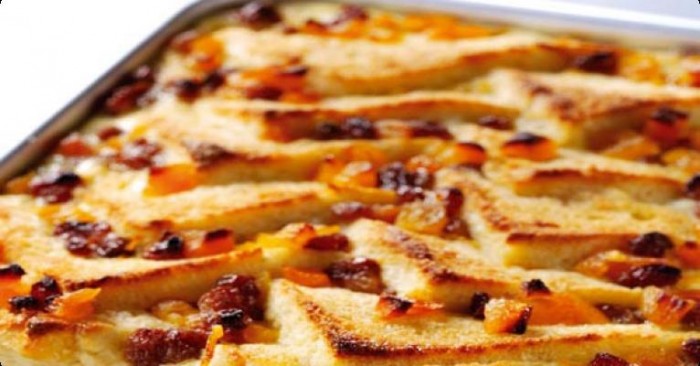An updated twist on a classic dessert. The tangy fruit really adds to the flavour and it’s a great dessert for kids to make.
Skills Check
Follow a recipe; follow food safety & hygiene rules; tidy away; crack an egg; use measuring spoons; use a measuring jug to liquids; use weighing scales; chop using bridge/claw technique safely; spread with a knife/spoon; use a citrus squeezer; beat ingredients together.
Allergens:
Gluten | Eggs | Milk | Sulphites| May contain soya
(Please note the allergens listed are indicative only. Allergens vary depending on brand; check the labels on the products you use.)
Equipment
Bowl, citrus zester and squeezer, kettle, knife, chopping board, mixing bowl, fork, large roasting tin, large roasting tray, weighing scales, measuring jug, teaspoon, small bowl, table knife, wooden spoon.
Ingredients (serves 15):
- 175g dried apricots
- 175g raisins
- Zest and juice of 2 oranges
- 10 slices medium sliced fibre enriched white bread
- 75g softened butter
- 600ml semi skimmed milk
- 6 medium British Lion eggs
- 100g caster sugar
- 2 tsp vanilla essence
- 2 tsp demerara sugar to sprinkle on top
Method
- Place the apricots and raisins in a bowl with the orange zest and juice. Leave to soak for at least 1 hour.
- Preheat the oven to 180°C or Gas Mark 4.
- Fill and boil a kettle of water.
- Spread the bread with the butter then remove and discard the crusts.
- Beat the milk, egg, sugar and vanilla together.
- Arrange half the bread in a single layer in the base of a large roasting tin, scatter over half the soaked fruit. Repeat with the remaining bread and fruit. Pour over the milk and egg mixture and set aside to soak for 10 minutes if time allows.
- Stand the tin in the base of a large roasting tray, pour hot water from the kettle into the tray to come half way up the outside of the pudding tin.
- Bake for 35-40 minutes or until the top is golden and the pudding set in the centre.
- Cover with foil if the top is becoming too brown. Serve warm.
So thinking about Apricot and Orange Pudding ...

Dried Fruit such as apricots and raisins are high in fibre and iron. A 30g portion counts as one portion of your 5-a-day.
Nutritional Information
| - | Energy | 858kJ / 204kcal | 10% |
| Med | Fat | 5.2g | 7% |
| Med | Saturates | 3.1g | 16% |
| Med | Sugar | 22.2g | 25% |
| Med | Salt | 0.5g | 9% |
per 110g serving
% of an adult's reference intake
Typical values per 100g: Energy 780kJ / 185kcal
Notes
A traffic light system is used on nutrition labels to make it easier to see which foods and drinks are lower in calories, fat, sugar and salt. Try and choose more ‘greens’ and ‘ambers’ and fewer ‘reds’, and stick to smaller portions of ‘reds’.
Just because a recipe or a food has a red traffic light doesn't mean you shouldn't eat it. Understanding why a food or recipe might have a red light can be helpful. For example oily fish is high in total fat and so any recipe containing oily fish is likely to be ‘red’ for fat. But it is recommended that we eat oily fish at least once a week because the type of fat it contains is beneficial for our health.
% Reference Intakes are also shown. Reference Intakes are guidelines about the approximate amount of particular nutrients and energy required for a healthy diet (based on an average-sized woman doing an average amount of physical activity). Most children will require less than these Reference Intakes. The contribution of one serving of a food or drink to the Reference Intake for each nutrient is expressed as a percentage.




